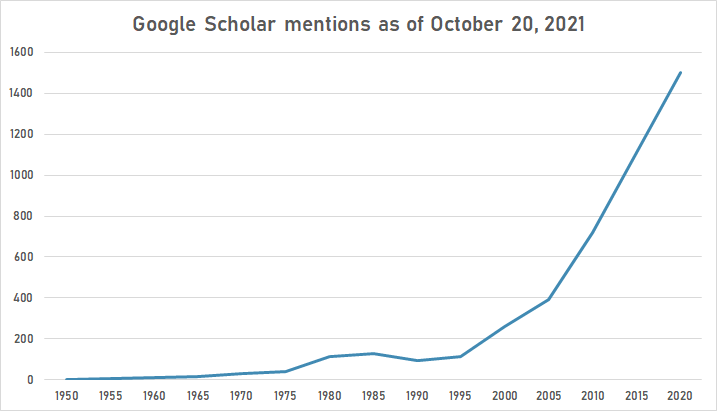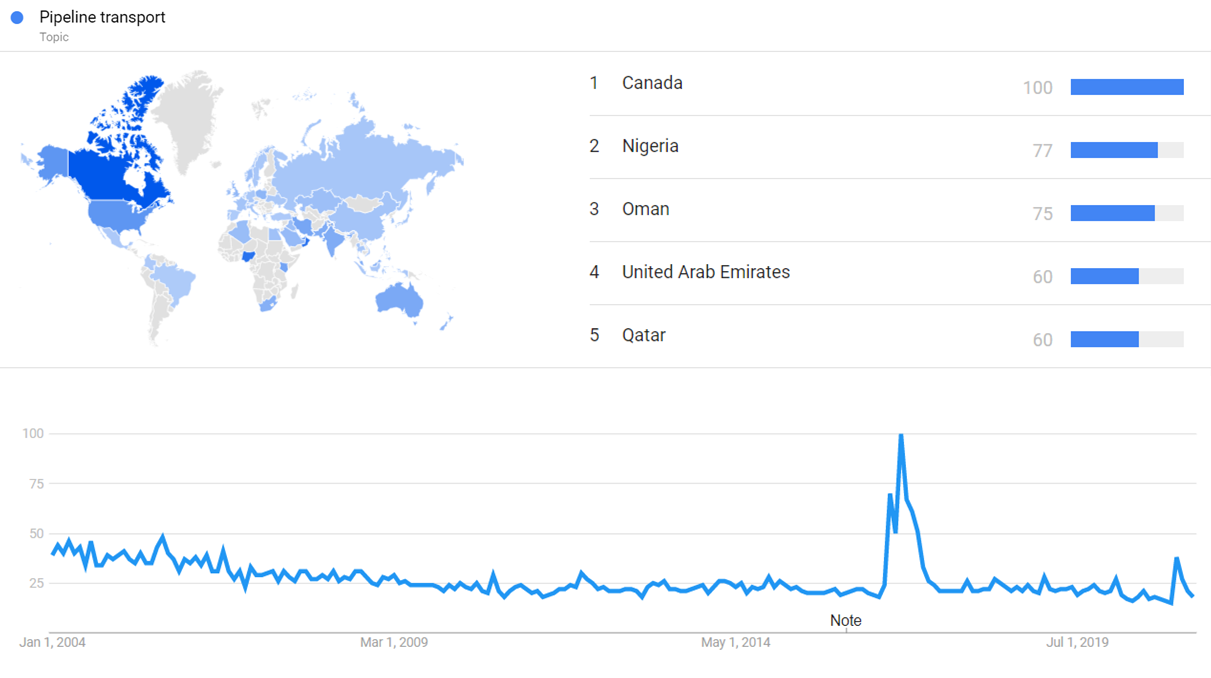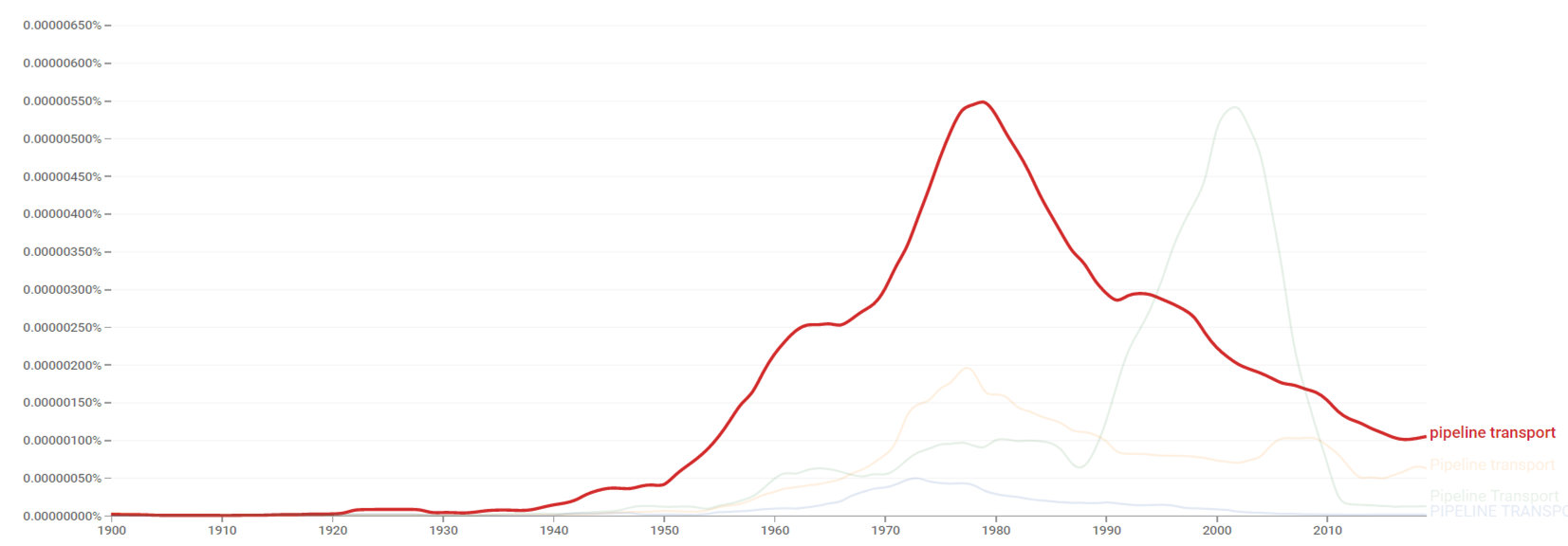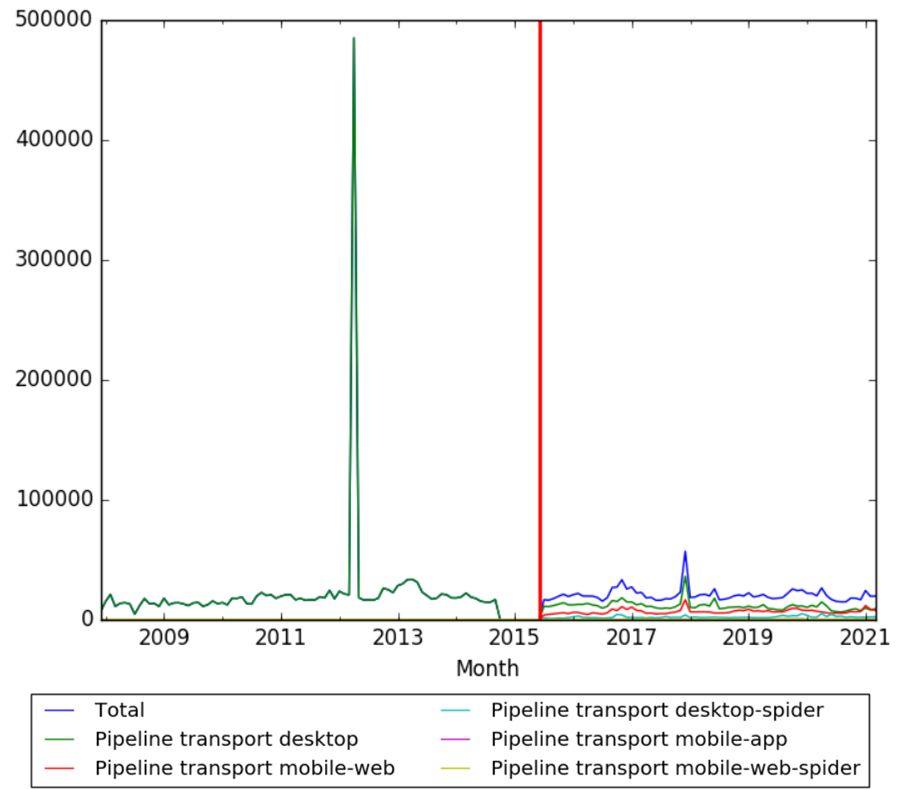Difference between revisions of "Timeline of pipeline transport"
(→Visual Data) |
|||
| (One intermediate revision by the same user not shown) | |||
| Line 18: | Line 18: | ||
|} | |} | ||
| − | |||
| − | |||
| − | |||
| − | |||
| − | |||
| − | |||
| − | |||
| − | |||
| − | |||
| − | |||
| − | |||
| − | |||
| − | |||
| − | |||
| − | |||
| − | |||
| − | |||
| − | |||
| − | |||
| − | |||
| − | |||
| − | |||
| − | |||
| − | |||
| − | |||
| − | |||
| − | |||
| − | |||
| − | |||
| − | |||
| − | |||
| − | |||
| − | |||
| − | |||
| − | |||
| − | |||
| − | |||
| − | |||
| − | |||
| − | |||
| − | |||
| − | |||
| − | |||
| − | |||
| − | |||
| − | |||
| − | |||
| − | |||
| − | |||
| − | |||
| − | |||
| − | |||
| − | |||
| − | |||
| − | |||
| − | |||
| − | |||
| − | |||
| − | |||
| − | |||
| − | |||
==Full timeline== | ==Full timeline== | ||
| Line 183: | Line 122: | ||
|- | |- | ||
|} | |} | ||
| + | |||
| + | == Numerical and visual data == | ||
| + | |||
| + | === Google Scholar === | ||
| + | |||
| + | The following table summarizes per-year mentions on Google Scholar as of October 20, 2021. | ||
| + | |||
| + | {| class="sortable wikitable" | ||
| + | ! Year | ||
| + | ! "pipeline transport" | ||
| + | |- | ||
| + | | 1950 || 1 | ||
| + | |- | ||
| + | | 1955 || 4 | ||
| + | |- | ||
| + | | 1960 || 9 | ||
| + | |- | ||
| + | | 1965 || 14 | ||
| + | |- | ||
| + | | 1970 || 33 | ||
| + | |- | ||
| + | | 1975 || 42 | ||
| + | |- | ||
| + | | 1980 || 116 | ||
| + | |- | ||
| + | | 1985 || 128 | ||
| + | |- | ||
| + | | 1990 || 92 | ||
| + | |- | ||
| + | | 1995 || 116 | ||
| + | |- | ||
| + | | 2000 || 258 | ||
| + | |- | ||
| + | | 2005 || 393 | ||
| + | |- | ||
| + | | 2010 || 719 | ||
| + | |- | ||
| + | | 2015 || 1,110 | ||
| + | |- | ||
| + | | 2020 || 1,500 | ||
| + | |- | ||
| + | |} | ||
| + | |||
| + | [[File:Pipeline transport gsch.png|thumb|center|700px]] | ||
| + | |||
| + | === Google Trends === | ||
| + | |||
| + | The chart below shows {{w|Google Trends}} data for Pipeline transport (Topic), from January 2004 to April 2021, when the screenshot was taken. Interest is also ranked by country and displayed on world map.<ref>{{cite web |title=Pipeline transport |url=https://trends.google.com/trends/explore?date=all&q=%2Fm%2F0dh21 |website=Google Trends |access-date=11 April 2021}}</ref> | ||
| + | |||
| + | [[File:Pipeline transport gt.png|thumb|center|600px]] | ||
| + | |||
| + | === Google Ngram Viewer === | ||
| + | |||
| + | The chart below shows {{w|Google Ngram Viewer}} data for Pipeline transport, from 1900 to 2019.<ref>{{cite web |title=Pipeline transport |url=https://books.google.com/ngrams/graph?content=Pipeline+transport&year_start=1900&year_end=2019&corpus=26&smoothing=3&case_insensitive=true |website=books.google.com |access-date=11 April 2021 |language=en}}</ref> | ||
| + | |||
| + | [[File:Pipeline transport ngram.png|thumb|center|700px]] | ||
| + | |||
| + | === Wikipedia Views === | ||
| + | |||
| + | The chart below shows pageviews of the English Wikipedia article {{w|Pipeline transport}}, on desktop from December 2007, and on mobile-web, desktop-spider, mobile-web-spider and mobile app, from July 2015; to March 2021. A data gap observed from October 2014 to May 2015 is the result of Wikipedia Views failure to retrieve data. A data gap on desktop observed from October 2014 to June 2015 is the result of Wikipedia Views failure to retrieve data.<ref>{{cite web |title=Pipeline transport |url=https://wikipediaviews.org/displayviewsformultiplemonths.php?page=Pipeline+transport&allmonths=allmonths&language=en&drilldown=all |website=wikipediaviews.org |access-date=11 April 2021}}</ref> | ||
| + | |||
| + | [[File:Pipeline transport wv.png|thumb|center|450px]] | ||
==Meta information on the timeline== | ==Meta information on the timeline== | ||
Latest revision as of 21:56, 25 March 2024
This is a timeline of pipeline transport, attempting to describe the evolution of pipelines mainly for urban and industrial purposes.
Contents
Big picture
| Time period | Development summary |
|---|---|
| Ancient times | Early pipeline systems are built for water supply and sanitation purposes. Notable exceptions include bamboo pipes for gas transportation in China. Pipes made of clay or stone are widely used in Egypt, Mesopotamia and Rome.[1] |
| 18th Century | Cast-iron pipes are introduced commercially, as cast iron becomes relatively cheap.[2] This leads to a significant improvement in pipeline technology.[3] |
| 19th Century | The oil industry escalates, and also the need to be transported at constant and accessible way. The Steel pipe, a major milestone, is introduced, greatly increasing the strength of pipes of all sizes. The development of high-strength steel pipes makes possible the transport of natural gas and oil over long distances.[3] Cast-iron pipes come into common use in the 1840s.[2] The first natural-gas and petroleum pipelines in the United States are built around this epoch.[2] In the 1870s, pipeline technology improves with the introduction of subsurface cast-iron pipes.[4] Pneumatic tube networks gained in the late 19th through early 20th centuries for offices that need to transport small, urgent packages over relatively short distances in meters. |
| 20th Century | Steel pipe is introduced early in the century.[2] In the 1920s, the application of welding to join pipes make it possible to construct leakproof, high-pressure, large-diameter pipelines. Since the 1950s, the introduction of ductile iron and large-diameter concrete pressure pipes for water and the use of polyvinyl chloride (PVC) pipe for sewers, prove to be major innovations.[3] From late 1950s to early 1960s, the largest Trans-Siberian trunk pipelines are built.[5] |
| Present time | Today, the most important pipeline networks are meant to supply oil and natural gas. As of 2014, data gives a total of slightly less than 3,500,000 km of pipeline in 120 countries.[6] The United States has 65%, Russia has 8%, and Canada has 3%, giving 75% of all pipelines in three countries.[6] |
Full timeline
The category material centers in the historical use of the material for pipes. Pipeline refers to the construction, existence or commissioning of important pipelines in the world. Statistics provides quantitative details with the purpose of illustrating the infraestructure development at the time. Background refers to important events within the context of pipeline development. Policy may refer to standard settings for the construction of pipelines.
| Year | Category | Content supplied (when applicable) | Event | Country/location |
|---|---|---|---|---|
| 5000 BC | Material | Water | Bamboo pipes are used in China to carry water.[1][2] | China |
| 4000 BC | Material | Water, wastewater? | The origin of the earliest known pipe in Babylonia is documented as one of the first places to mold clay into pipe (via potter’s wheel). Tees and angle joints are produced and then baked to make drainage pipe.[7] | |
| 3200 BC–2300 BC | Material | Water, wastewater | In the Minoan civilization several types of stone and terracotta conduits and pipes are used to transfer water, and drain stormwater and wastewater.[7] Clay pipes transport water and drainage system develops, working with the natural gradations of the terrain, to manage sewage and water overflow.[8][9] | Greece |
| 3000 BC | Material | The first metal pipes of copper are made in Egypt.[2] | Egypt | |
| 2500 BC | Material | Water, wastewater? | In Egypt, copper pipes are used to build elaborate bathrooms inside the pyramids and intricate irrigation and sewages systems.[7] | Egypt |
| 525 BC | Material | Water | A long distance pipeline made out of ox–hides sewn together is laid across the desert to supply water to the Persian forces during the invasion of Egypt by Cambyses II.[1] | |
| 480 BC–67 BC | Material | Water | The Hellenes use pipes of lead and bronze to distribute water.[7] | Greece |
| 400 BC | Material | Natural gas | Bamboo pipes are used to transmit natural gas to light Beijing.[3] | China |
| 1830s | Material | Iron pipes for other uses other than oil transportation already operate in the United States.[10] | United States | |
| 1840s | Material | Cast-iron pipes come into common use, providing resistance to corrosion better than steel pipes, and being therefore frequently used underground.[2] | ||
| 1859 | Background | Oil | The first commercial oil well in the United States is drilled by “Colonel” Edwin Drake in Titusville, Pennsylvania. Soon after, the use of pipe for oil transportation starts in the country.[10] | United States |
| 1860s | Policy | Quality control of pipe manufacturing develops as the pipeline business grows. Also, the type of metal for pipes improves from wrought iron to steel.[10] | United States | |
| 1861 | Material | Oil | The first crude oil pipeline is constructed of wood in the United States.[1] | United States |
| 1862–1863 | Pipeline | Oil | Pennsylvania oilman J.L. Hutchinson attempts to build a pipeline, running over a hill, to a refinery, and working on the principle of a siphon: as long as the outlet is lower than the inlet, liquid flows. The pipe wouldn't work for not being airtight. Over the next year Hutchinson tries again, building a 2-mile line. Although leaking, the combination of pumps and pipes manage to work well enough to be considered a success.[11] | United States |
| 1863 | Russian chemist Dmitri Mendeleev proposes the idea of using a pipeline to transfer oil and products of oil refining.[5] | Russia | ||
| 1865 | Pipeline | Oil | An early modern oil pipeline is built in Pennsylvania by S. F. Karns to counteract the high transport cost imposed by teamsters who haul oil over a five–mile route for US$3 a barrel.[1] | United States |
| 1872 | Statistics | Oil | 1,200 wells in the Pennsylvania region produce 6 million barrels of oil a year, all of it gathered through pipelines.[11] | United States |
| 1878 | Pipeline | Oil | The first pipeline is put into operation in Russia, for carrying oil.[5] | Russia |
| 1880 | Pipeline | Oil | The Cleveland line pipeline is completed by American company Standard Oil, reducing shipping costs by more than half. At this time Standard Oil is building its own pipelines towards its refineries in the United States.[4] | United States |
| 1882 | Statistics | American magnate John D. Rockefeller controlls 3,000 miles of pipelines.[4] | United States | |
| 1905 | Oil | Crude oil pipelines start carrying oil from the fields in Texas, Oklahoma and Kansas to the refineries in the East.[12] | United States | |
| 1906 | Pipeline | Kerosene, crude oil | The w:Baku–Batumi pipeline:Baku–Batumi fuel line is the first trunk pipeline built in the Russian Empire. At the time, it is the world’s largest system with 882 km length, 204 mm diameter and a capacity of 900 thousand tons per year.[5] | Azerbaijan, Georgia |
| 1906 | Policy | The Hepburn Act in the United States makes interstate pipelines common carriers that are required to offer their services at equal cost to all shippers.[12] | United States | |
| 1912 | Pipeline | Natural gas | A 275 Km natural gas pipeline is built by the Canadian Western Natural Gas from Bow Island, Alberta, to Calgary.[13] | Canada |
| 1914 | Statistics | Oil | Three trunk pipelines operate in Russia: Maykop – Krasnodar, Kaluzhskaya – Afipskaya and Makhachkala – Groznyi.[5] | Russia |
| 1917 | Statistics | The total extent of pipes in Russia equals to 1100 kilometers, with no further extension for over a decade.[5] | Russia | |
| 1920s | Statistics | The total pipeline mileage in the United States grows to over 115,000 miles, driven by the growth of the automobile industry.[12] | United States | |
| 1923 | Pipeline | Natural gas | A 124 kilometres natural gas pipeline and 129 kilometres of distribution pipeline are built by Northwestern Utilities Company Limited from Viking, Alberta to Edmonton.[13] | Canada |
| 1928 | Pipeline | Construction of large pipeline system in the USSR is resumed, when the Groznyi – Tuapse pipeline (250 mm in diameter, 618 km long) is put into operation.[5] | Russia | |
| 1936 | Pipeline | Crude oil | The Ishimbay–Ufa pipeline (166 km long, 300 mm in diameter) is put in operation, ensuring a non-stop crude oil supply to the Ufa oil refinery.[5] | Russia |
| 1954 | Indiana Standard pipeline company Stanolind, becomes the largest liquid pipeline carrier in North America, a position it would hold until the Enbridge expansion.[14] | United States | ||
| 1955 | Material | Ductile cast-iron pipe becomes the industry standard, being used in water distribution systems. It becomes the industry standard for metal due to its superior strength, durability, and reliability over cast iron. The pipe is used to transport potable water, sewage, and fuel, and is also used in fire-fighting systems.[15] | ||
| 1957 | Pipeline | Natural gas | TransCanada pipeline begins construction on a natural gas pipeline across Canada. Natural gas transportation begins from northeastern British Columbia to the BC/US border. The TransCanada Pipeline’s Alberta system also begins operations."[13][16] | Canada |
| 1956 | Pipeline | Milk | Pipelines are successfully used to transport milk in parts of Switzerland.[1][17] | Switzerland |
| 1970 | Pipeline | Coal slurry | The Black Mesa pipeline is built in the United States. The 18-inch pipeline transports 4.8 million tons of coal per year from Black Mesa, Arizona, to southern Nevada, over a distance of 273 miles. It is the longest coal-slurry pipeline in the world.[3] | United States |
| 1973 | Pipeline | Oil | The construction of the Aleksandrovskoye–Anzhero-Sudzhensk oil pipeline, with the diameter of 1220 mm and with the extent of 817 km, is completed. Western Siberia becomes the leader in the USSR in oil production.[5] | Russia |
| 1977 | Pipeline | The Trans-Alaska Pipeline is completed.[14] | United States | |
| 1983 | Pipeline | Natural gas | The 2475 km long Trans–Mediterranean natural gas pipeline is built to transport natural gas from Algeria to Italy via Tunisia. It has the capacity to deliver 30.2 bcm/y of natural gas.[16] | Algeria, Italy, Tunisia |
| 1991 | A Capsule Pipeline Research Center is established at the University of Missouri in Columbia, jointly funded by industry and the government.[3] | United States | ||
| 1992 | Policy | Oil | The United States Congress passes the Energy Policy Act (EPAct), requiring Federal Energy Regulatory Commission to establish a "simplified and generally applicable" ratemaking methodology for oil pipelines. In response, the FERC would issue a rulemaking in which it adopts the industrywide oil pipeline rate indexing methodology, which is the most frequently used approach to set oil pipeline rates.[14] | United states |
| 1993 | Organization | The Canadian Energy Pipeline Association is founded.[13] | Canada | |
| 1997 | Pipeline | Natural gas | The 463 km long GasAndes Pipeline is commissioned. With a diameter of 610 mm and an annual capacity of 3.3 bcm, it is supplied mainly from the Neuquén gas fields.[18] | Argentina, Chile |
| 2000 | Pipeline | Natural gas | The 3150 km long Bolivia–Brazil pipeline (GASBOL) is completed. It is the longest natural gas pipeline in South America, having a total cost of US$ 2.15 billion, of which US$ 1.72 billion is spent on the Brazilian section and US$ 435 million on the Bolivian section.[16] | Bolivia. Brazil |
| 2001 | Pipeline | Oil | The Baltic Pipeline System (BPS) is created for oil transportation. The BPS transports oil from the Timan-Pechora region, West Siberia and Urals-Volga regions to Primorsk oil terminal at the eastern part of the Gulf of Finland.[5] | |
| 2005 | Pipeline | Natural gas | The 4196 km long Yamal–Europe pipeline reaches full capacity. It connects the natural gas fields in Western Siberia with Germany. The pipeline has a capacity of 33 bcm of natural gas per annum. The diameter of the pipeline is 1420 mm.[16] | Russia, Poland, Germany, Belarus |
| 2005 | Pipeline | Natural gas | The 935 km long Parallel Shaan-Jing Pipeline is completed and put into operation. The pipeline is supplied from the Sulige Gas Field and it starts from the gas processing plant Yulin, Shaanxi. The pipeline runs via Shijiazhuang to Beijing.[19] | China |
| 2005 | Pipeline | Natural gas | The The 886 km long Ji–Ning branch of the West–East Gas Pipeline becomes fully operational.[16] | China |
| 2010 | Pipeline | Natural gas | The construction of the first 1,360 km section of the Sichuan–Shanghai gas pipeline from Yichang in Hubei Province to Shanghai is completed.[20] | China |
Numerical and visual data
Google Scholar
The following table summarizes per-year mentions on Google Scholar as of October 20, 2021.
| Year | "pipeline transport" |
|---|---|
| 1950 | 1 |
| 1955 | 4 |
| 1960 | 9 |
| 1965 | 14 |
| 1970 | 33 |
| 1975 | 42 |
| 1980 | 116 |
| 1985 | 128 |
| 1990 | 92 |
| 1995 | 116 |
| 2000 | 258 |
| 2005 | 393 |
| 2010 | 719 |
| 2015 | 1,110 |
| 2020 | 1,500 |
Google Trends
The chart below shows Google Trends data for Pipeline transport (Topic), from January 2004 to April 2021, when the screenshot was taken. Interest is also ranked by country and displayed on world map.[21]
Google Ngram Viewer
The chart below shows Google Ngram Viewer data for Pipeline transport, from 1900 to 2019.[22]
Wikipedia Views
The chart below shows pageviews of the English Wikipedia article Pipeline transport, on desktop from December 2007, and on mobile-web, desktop-spider, mobile-web-spider and mobile app, from July 2015; to March 2021. A data gap observed from October 2014 to May 2015 is the result of Wikipedia Views failure to retrieve data. A data gap on desktop observed from October 2014 to June 2015 is the result of Wikipedia Views failure to retrieve data.[23]
Meta information on the timeline
How the timeline was built
The initial version of the timeline was written by User:Sebastian.
Funding information for this timeline is available.
What the timeline is still missing
- Visual data illustrating the pipeline network evolution at a worldwide level. Also more mention on important pipelines is needed.
- Trans-Alaska Pipeline System
- [1]
Timeline update strategy
See also
External links
References
- ↑ 1.0 1.1 1.2 1.3 1.4 1.5 "Historical Development of the Pipeline as a Mode of Transportation" (PDF). gammathetaupsilon.org. Retrieved 18 August 2017.
- ↑ 2.0 2.1 2.2 2.3 2.4 2.5 2.6 "pipe". factmonster.com. Retrieved 18 August 2017.
- ↑ 3.0 3.1 3.2 3.3 3.4 3.5 "Pipeline technology". britannica.com. Retrieved 18 August 2017.
- ↑ 4.0 4.1 4.2 Zrinski, Tara M. "Pipelines By". philadelphiaencyclopedia.org. Retrieved 19 August 2017.
- ↑ 5.0 5.1 5.2 5.3 5.4 5.5 5.6 5.7 5.8 5.9 "Pipelines History". transneft.ru. Retrieved 18 August 2017.
- ↑ 6.0 6.1 "Pipelines CIA". cia.gov. Retrieved 18 August 2017.
- ↑ 7.0 7.1 7.2 7.3 De Feo, Giovanni; Antoniou, George; Fardin, Hilal Franz; El-Gohary, Fatma; Zheng, Xiao Yun; Reklaityte, Ieva; Butler, David; Yannopoulos, Stavros; Angelakis, Andreas N. "The Historical Development of Sewers Worldwide". doi:10.3390/su6063936. Retrieved 22 August 2017.
- ↑ "History of Plumbing Systems". homeadvisor.com. Retrieved 6 August 2017.
- ↑ Angelakis, Andreas N.; Snyder, Shane A. (9 September 2015). "Wastewater Treatment and Reuse: Past, Present, and Future". Water. 7 (9): 4887–4895. doi:10.3390/w7094887.
- ↑ 10.0 10.1 10.2 "The History of Pipelines". pipeline101.org. Retrieved 17 August 2017.
- ↑ 11.0 11.1 Waldman, Jonathan. "How the Oil Pipeline Began". nautil.us. Retrieved 18 August 2017.
- ↑ 12.0 12.1 12.2 "The History of Pipelines". pipeline101.org. Retrieved 17 August 2017.
- ↑ 13.0 13.1 13.2 13.3 "How long has the pipeline industry been around?". aboutpipelines.com. Retrieved 18 August 2017.
- ↑ 14.0 14.1 14.2 "The History of Pipelines". pipeline101.org. Retrieved 17 August 2017.
- ↑ "Water Supply and Distribution Timeline". greatachievements.org. Retrieved 8 August 2017.
- ↑ 16.0 16.1 16.2 16.3 16.4 Menon, Shashi. Transmission Pipeline Calculations and Simulations Manual. Retrieved 25 August 2017.
- ↑ "Swiss use hose to transport milk down mountainside in 1956". gettyimages.co.uk. Retrieved 27 August 2017.
- ↑ Menon, Shashi. Transmission Pipeline Calculations and Simulations Manual. Retrieved 26 August 2017.
- ↑ "CASES". petrobest.com. Retrieved 27 August 2017.
- ↑ "Sinopec starts up Sichuan-East China gas project". Reuters. Retrieved 27 August 2017.
- ↑ "Pipeline transport". Google Trends. Retrieved 11 April 2021.
- ↑ "Pipeline transport". books.google.com. Retrieved 11 April 2021.
- ↑ "Pipeline transport". wikipediaviews.org. Retrieved 11 April 2021.



